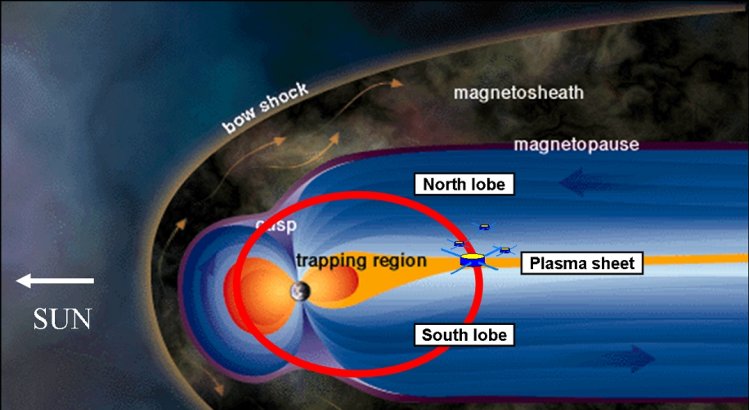
Planetary Magnetospheres
In the near-space environment of a planet with a sufficiently strong internally-generated magnetic field, a cavity will form as a consequence of this magnetic field separating plasmas of planetary origin from those of the surrounding solar wind. This cavity is the magnetosphere, and a boundary, called the magnetopause, marks its edge. IRF has a long-standing research programme in the field of planetary magnetospheres, not only on Earth but also on the other magnetised planets found in our solar system.
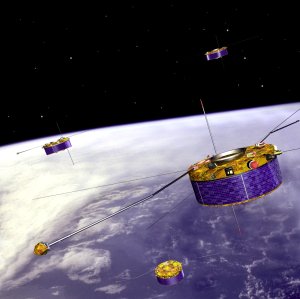
The magnetosphere of the Earth is naturally the most studied, and a great deal is known about the structure of the magnetosphere, and how its size and shape are influenced by external effects such as space weather events, including the impact of interplanetary-travelling coronal mass ejections, and stream interaction regions originating from the solar surface. Here, our research into fundamental plasma processes such as magnetic reconnection is central, as this provides insight as to how the Earth’s magnetic field is coupled to that of the heliosphere, and how energy and material are exchanged across the otherwise “impermeable” magnetopause. At IRF, a recent highlight of our research has been the use of ESA’s Cluster mission, consisting of four identical spacecraft, that have been in orbit around the Earth since 2000. These four spacecraft, flying in a tetrahedral formation, allow us to resolve both spatial and temporal changes in the properties of the plasma and magnetic fields around the Earth. This mission, on which we have developed and operated the Electric Field and Waves instrument package, has provided much greater understanding of the detailed physics of processes such as reconnection, auroral acceleration, plasma boundary motion, cold ion outflow. EFW consists of four probes on each spacecraft mounted on long wire booms, from which the electric field can be measured in the spin-plane of each spacecraft. The multi-spacecraft nature of the Cluster mission, and the range of spacecraft separation distances used over the mission has allowed us to characterise these processes at a range of spatial and temporal scales.
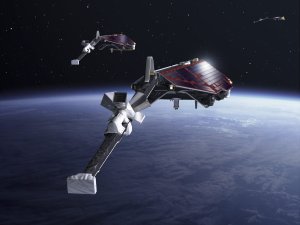
In addition to Cluster, we perform research using the multi-spacecraft missions Magnetospheric Multiscale (MMS, NASA) launched 2015 and Swarm (ESA) launched 2013. IRF-Uppsala is again involved directly in both missions, providing the Langmuir probe instrument suite on Swarm. On MMS, in collaboration with the Royal Institute of Technology (KTH) in Stockholm, we are involved with the electric field and waves instruments, addressing similar physics to Cluster, targeted towards developing a greater understanding of magnetic reconnection and its effects.
While it is particularly important to understand the behaviour of Earth’s magnetosphere, both as a curiosity but also in the context of space weather hazards, the knowledge we gain here can be transferred to fundamentally similar systems both at the other magnetised bodies in the solar system, and indeed throughout the universe.
- Mats André is the PI for the EFW instrument on Cluster, also using MMS data to study plasma physics
- Yuri Khotyaintsev studies the physics of reconnection and its effects on plasmas and waves
- Stephan Buchert focuses on Swarm data analysis and the substorm cycle
- Daniel Graham is studying magnetic reconnection at Earth’s magnetopause, primarily focusing on electron dynamics and waves
- Emiliya Yordanova is investigating solar wind turbulence; coronal mass ejections and their space weather effects on Earth; magnetic reconnection in turbulent plasma
- Andrew Dimmock is investigating the magnetosphere-ionosphere coupling processes that result in localised geomagnetic disturbances and geomagnetically induced currents.
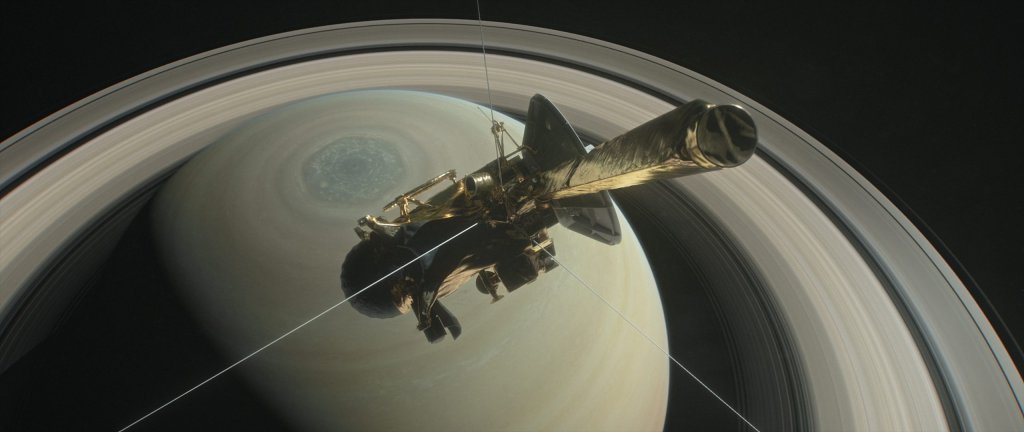
Cassini is a joint mission between NASA, ESA, and the Italian Space Agency ASI. The Cassini spacecraft has been investigating Saturn and its magnetospheric environment since 2004. Saturn has an intense, and almost perfectly symmetric magnetic field, and a major plasma source is present deep in the magnetosphere, at the small moon Enceladus. Tidal heating and resulting cryovolcanism here lead to the emission of water ice and gas from the south pole of the moon, which ultimately fills the magneto-disc of Saturn with a water-group ion plasma. These factors, combined with the rapid rotation of the planet lead to significantly different magnetospheric dynamics at Saturn than those typical in the Earth magnetosphere. One major focus of the Cassini mission has been the study of puzzling modulations detected in the planet’s magnetic field, plasma populations, and radio emissions.
IRF has developed and is operating the Langmuir probe, a part of the Radio and Plasma Wave Science (RPWS) instrument suite. This is used to investigate the plasma environment around Saturn. Our main focus is to study the inner plasma disk, the dusty plasma environment of the moon Enceladus, and the ionosphere of Titan. From the Langmuir probe we derive electron and ion densities, temperatures, velocities, and estimate the charging of the spacecraft. We also study flybys of the moon of Titan, with its thick atmosphere, hydrocarbon lakes and methane rains. Here our instrument have contributed to the knowledge on the structure and dynamics of the ionosphere, how the complex organic molecules are created in the upper atmosphere, and how these molecules further on is the constituent of the organic haze (aerosol) clouding the skies of Titan with an orange-brown organic haze. Titan’s ionosphere and upper atmosphere is thought to have similarities to the early Earth’s atmosphere and is therefore of astro-biological interest with regard to the production of pre-biotic molecules.
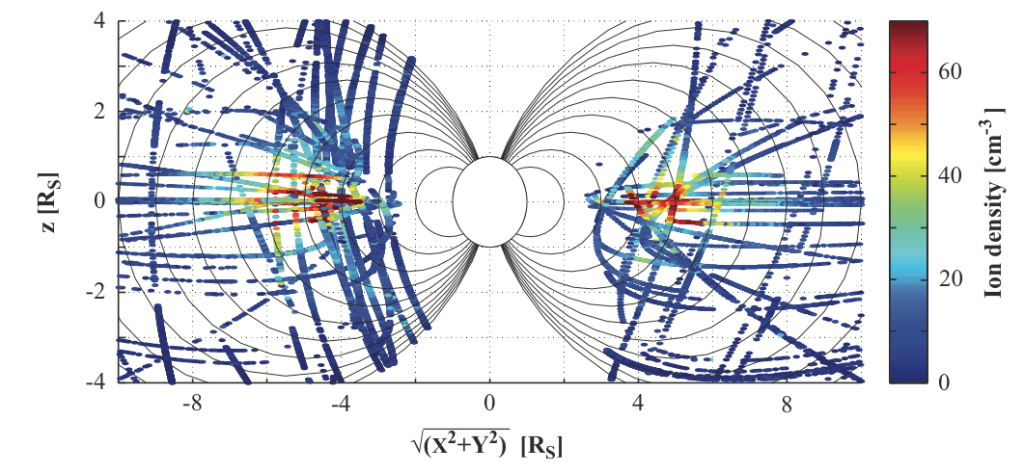
The Cassini mission will end in 2017 when the spacecraft enters Saturn’s atmosphere, following a period of highly-inclined, low periapsis altitudes which will hopefully shed new light on the physics of the Saturnian magnetosphere.
- Niklas Edberg is studying Titan’s ionosphere structure and development and interaction with the Kronian magnetosphere
- Jan-Erik Wahlund is PI on the Cassini Langmuir Probe
- Erik Vigren is investigating the formation of Titan’s ionosphere
- Dave Andrews is studying magnetic field data, examining rotation-period oscillations in the magnetosphere
- Michiko Morooka studies Saturn’s magnetosphere using Cassini data
Unlike Earth, Mars does not possess a global magnetic field, and instead the solar wind is able to interact directly with the upper reaches of the planet’s atmosphere and ionosphere. Consequently, electrodynamic currents are created in Mars’ ionosphere, the magnetic field of the solar wind ‘piles up’ in front of the planet and is draped around it, forming an ‘induced magnetosphere’. A similar type of solar wind-ionosphere interaction is found at Venus, and to some extent at Saturn’s large moon Titan. By comparing these three systems, we hope to learn more about the physical processes controlling them.
At Mars, we use data from the Mars Advanced Radar for Sub-surface and Ionospheric Sounding (MARSIS) on MEX to measure the plasma density in the Martian ionosphere, from the spacecraft down to the maximum density surface, by detecting the reflection of radio pulses at different frequencies. We also examine data from the ASPERA-3 instrument package, operated by colleagues in IRF-Kiruna, which measures the higher-energy plasmas found in the Martian environment, including the density, speed and temperature of the solar wind. Recently, the NASA MAVEN mission arrived at Mars, and we are involved in the analysis of data from the Langmuir Probe and Waves instrument package (somewhat similar to instruments we operate on Cassini, Rosetta, Swarm, …).
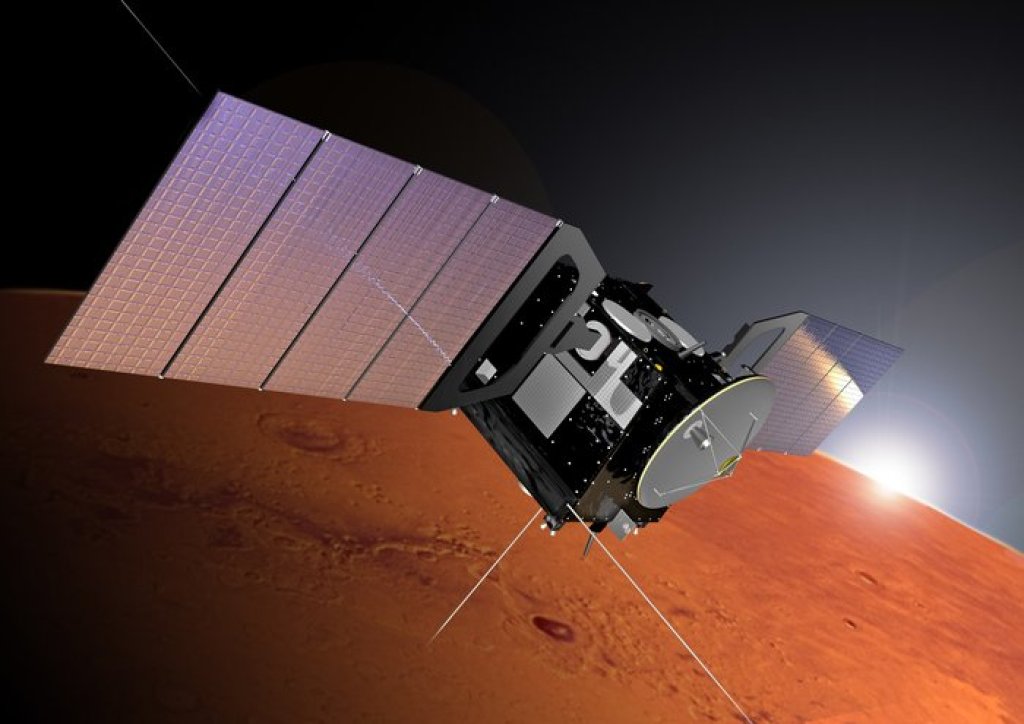
In particular, we study the effects of solar wind-driven changes in the Martian plasma environment, and the interaction between the draped magnetosphere-ionosphere and the crustal fields.
- Anders Eriksson is a Co-I on the LPW experiment on MAVEN
- Dave Andrews is a researcher, actively involved in both MEX and MAVEN missions and data analysis
- Niklas Edberg is involved in MEX
- We are involved in the Mars Upper Atmosphere Network, organising a series of successful small workshops over the past six years to study the Martian plasma environment
JUICE
The next large ESA mission will be the JUpiter ICy moons Explorer (JUICE). It is scheduled for launch in 2022 and will arrive to Jupiter in 2030. The main objectives are to study Jupiter’s largest icy moons, Callisto, Ganymede and Europa, and how these moons interact with the space environment around Jupiter. Sweden contributes strongly to this mission, and IRF in Uppsala leads one of eleven international instrument consortia. Our provided instrument suite is the Radio and Plasma Wave Investigation (RPWI), consisting of an electric field and Langmuir probe experiment (GANDALF), a magnetic search coil experiment (SAMWISE), a radio wave experiment (JENRAGE) as well as an active stimulating plasma experiment (MIME). The large icy moons (Europa, Ganymede and Callisto) are believed to all harbor sub-surface oceans that may be habitable. These oceans are most probably salty and therefore electrically conductive. The Jovian magnetosphere varies in time, induce currents in the ionospheres of the icy moons, and in the magnetosphere of Ganymede, that in turn induce electric currents in the conductive sub-surface oceans, there providing an energy source for possible life, and then the whole electrodynamic interaction can be traced back into the Jovian space environment again, where the interaction with the moons produce Alfvén wing disturbances that creates aurora-like emission footprints on Jupiter itself. Ganymede will also provide a unique opportunity to study a magnetosphere inside a magnetosphere since it is the only known moon with its own magnetic field, and Ganymede is known to have its own aurora.
- Jan-Erik Wahlund is the principal investigator (PI) for the Radio and Plasma Wave Investigation (RPWI) instrument
BepiColombo
The BepiColombo mission is a joint ESA and JAXA mission with two spacecraft, the Mercury Magnetospheric Orbiter (MMO) and the Mercury Planetary Orbiter (MPO). The mission was launched in 2018 and will reach Mercury in 2025. The main objectives of BepiColombo are to study Mercury, its interior structure, surface, magnetic field, and magnetosphere. Mercury has a very interesting magnetosphere to study, since it has no ionosphere and is so close to the Sun, resulting in a massive emission of photoelectrons on the dayside of the planet. These unusual conditions give rise to interesting problems concerning the closure of the magnetospheric currents. IRF in Uppsala and KTH have provided the electric field experiment Mercury Electric Field In Situ TOol (MEFISTO) on board the Japanese orbiter MMO. The MEFISTO instrument will make the first-ever in situ measurements of static and electric fields in Mercury’s environment. It will also investigate, e.g., particle acceleration structures, field-aligned currents and their closure, plasma convection, charge flow between hemispheres and substorm phenomena.
- Jan-Erik Wahlund is the Co-PI of PWS/MEFISTO on MMO
